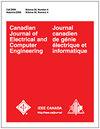Characterizing Horn Antenna Signals for Breast Cancer Detection
IF 1.7
Q2 Engineering
Canadian Journal of Electrical and Computer Engineering-Revue Canadienne De Genie Electrique et Informatique
Pub Date : 2018-04-19
DOI:10.1109/CJECE.2017.2775160
引用次数: 4
Abstract
An in-depth analysis of signals from horn antennas used in breast cancer detection research has been carried out. It was found that following the excitation signal, both the double-ridged and the quad-ridged ultra-wideband horn antennas radiate additional unwanted signals that persistently oscillate. Undesirable signal oscillations sources were identified as the horn antenna cavity resonance and inherent antenna LC resonance. These signals interfere with the tumor’s signal response and need to be eliminated for successful detection of the cancerous growth. This paper proposes solutions to remove or minimize these signals without affecting antenna parameters such as bandwidth, gain, ports isolation, and polarization isolation. Modification of the antenna cavity successfully suppressed the unwanted cavity oscillation. Modification of the antenna waveguide reduced inductance and consequently mitigated LC oscillation. The resulting time and frequency domain horn antenna signals demonstrate the effectiveness of the proposed methods. Finally, a breast phantom with a tumor is simulated using signals from the original and a modified horn antenna. The delay and sum method is used to create images. The breast images demonstrate enhanced image quality through the reduction of clutter using the proposed techniques. The signal-to-clutter ratios are 0.448 and 1.6823 dB for the images produced by using the original and modified antennas, respectively.用于乳腺癌症检测的喇叭天线信号特征
对乳腺癌症检测研究中使用的喇叭天线的信号进行了深入分析。研究发现,在激励信号之后,双脊和四脊超宽带喇叭天线都会辐射出持续振荡的额外不需要的信号。不理想的信号振荡源被确定为喇叭天线谐振腔和固有天线LC谐振。这些信号干扰肿瘤的信号反应,需要消除这些信号才能成功检测癌细胞的生长。本文提出了在不影响天线参数(如带宽、增益、端口隔离和极化隔离)的情况下去除或最小化这些信号的解决方案。天线谐振腔的改进成功地抑制了不希望有的谐振腔振荡。天线波导的改进降低了电感,从而减轻了LC振荡。所得到的时域和频域喇叭天线信号证明了所提出方法的有效性。最后,使用来自原始和改进的喇叭天线的信号模拟带有肿瘤的乳房模型。延迟和求和方法用于创建图像。通过使用所提出的技术减少杂波,乳房图像显示出增强的图像质量。对于使用原始天线和改进天线产生的图像,信杂比分别为0.448和1.6823dB。
本文章由计算机程序翻译,如有差异,请以英文原文为准。
求助全文
约1分钟内获得全文
求助全文
来源期刊

自引率
0.00%
发文量
27
期刊介绍:
The Canadian Journal of Electrical and Computer Engineering (ISSN-0840-8688), issued quarterly, has been publishing high-quality refereed scientific papers in all areas of electrical and computer engineering since 1976
 求助内容:
求助内容: 应助结果提醒方式:
应助结果提醒方式:


